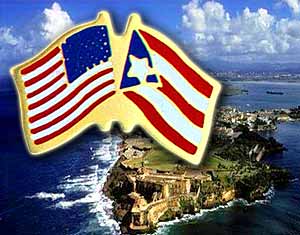24.06.2008
June 20, 2008 (the date of publication in Russian)
Alexei Chichkin
PUERTO RICO DREAMS OF LIBERTY
Island authorities demand accretion of power
 In his speech at the session of the Special Committee on Decolonization, UN Secretary-General Ban Ki Moon emphasized that the ideas of the 1960-adopted Declaration on Granting Independence to Colonial Countries and Peoples will be fully implemented only after the final determination of the status of the sixteen remaining non-self-governing territories.
In his speech at the session of the Special Committee on Decolonization, UN Secretary-General Ban Ki Moon emphasized that the ideas of the 1960-adopted Declaration on Granting Independence to Colonial Countries and Peoples will be fully implemented only after the final determination of the status of the sixteen remaining non-self-governing territories.
Despites efforts of the US State Department, the United Nations still includes three US colonies in the list: namely, Guam, Western Virgin Isles, and Eastern Samoa.
The isle of Puerto Rico is struck off the list. However, the 1972 resolution of the UN Special Committee enunciates necessity to guarantee the right of Puerto Rico's population for self-determination and independence. Thus, the United Nations still does not legally recognize today's status of Puerto Rico as a "state, freely associated with the United States of America".
Though only 5% of Puerto Ricans keep insisting on full independence from Washington, this existing ferment enables the local establishment to successfully prevent the isle's transformation into a US state and wrest out more and more concessions from the White House in accretion of power.
In August 2007, the ruling Popular Democratic Party addressed the US State Department, demanding a right for independent foreign trade. Puerto Rican administrative and corporate bodies are dissatisfied with the economic and legal dependence from Washington, especially with the obligation to register transit goods in the United States. The islanders would like to have a possibility to sign direct trade agreements with foreign countries, predominantly with Ibero-American neighbors.
In particular, Puerto Rico is interested in expanding trade links with Venezuela. President Hugo Chavez repeatedly visited the island, making friends with many local politicians. Though he – for understandable reasons – refrained from visits during last years, his political ideas are becoming more and more popular here. Analysts believe that the ruling party intends to acquire the status of a US dominion for the island, in order to combine the advantages of a protectorate and a sovereign state.
Though officially listed as US citizens since 1917, Puerto Ricans do not pay federal taxes, and also don't take part in US Presidential elections. The latter right, however, is not very attractive today. Puerto Ricans would more appreciate independence from Washington and US corporations.
The Puerto Rican movement for independence has existed during the whole period since the 1898 annexation by the United States. In 1947, Washington permitted the islanders to elect their governor, but these partial rights did not satisfy the freedom-seekers. On November 1, 1950, two activists of Puerto Rican Nationalist Party, Griselio Torresola and Oscar Collazo, undertook an attempt to assassinate US President Harry Truman. This happened at the culmination of the nationalist movement, spearheaded by the now legendary PRNP leader Pedro Albizu Campos.
Though the FBI severely suppressed the unrest, the White House agreed to allow the islanders to adopt their own constitution. According to the legislation passed in 1952, the territory of Puerto Rico and the adjacent isles of Vieques, Culebra, Mona, Desecheo, and Caja de Muertos acquired the status of "Associated Free State of Puerto Rico" (Estado Libre Asociado de Puerto Rico).
In the second half of the XX century, most of the Puerto Rican population has been moving to the continent, mostly due to economic reasons. Within a decade between 1945 and 1955, the quantity of Puerto Ricans dwelling in New York City increased from 13,000 to 500,000. Today, over 2.5 million of Puerto Ricans reside in the United States.
One more outburst of the nationalist ferment took place in 1958, on the 60th anniversary of the US conquest. Since that time, an underground guerilla organization, named Armed Force of Puerto Rican National Liberation, operates on the island, sporadically enjoying support from China and Cuba.
In the new century, the nationalist ferment acquired the form of massive protests against militarization of the Vieques isle, where the US military used to carry out testing of new weapons at the range built in 1940 for the needs of the Navy. The protests increased after the US Army tested projectiles with depleted uranium, subsequently used in Yugoslavia. In May 2003, the State Dept was forced to convey one half of the isle's territory to the local population.
However, the US Navy base still exists, arousing new protests from the remaining 11,000 population. On Guam (similarly overtaken during the war for the Spanish colonial legacy in 1898), the US military enjoy more conveniences, as the whole of its population was extradited from the isle.
At present, that a number of states, mostly represented in the Non-Aligned Movement, are going to initiate a joint conference on decolonization of the Pacific and Caribbean islands under the auspices of the UN. Thus, despite all the efforts of the State Dept, the issue of Puerto Rican independence is still on the table. It is noteworthy that five public schools in San Juan are presently named after Pedro Albizu Campos, who perished in 1965 after fourteen years of custody where he is believed to have undergone radiological experiments – the case Russians should remind of when blamed for the death of ex- KGB Colonel Alexander Litvinenko in London.
Number of shows: 1195
 ENG
ENG 

 ENG
ENG 
